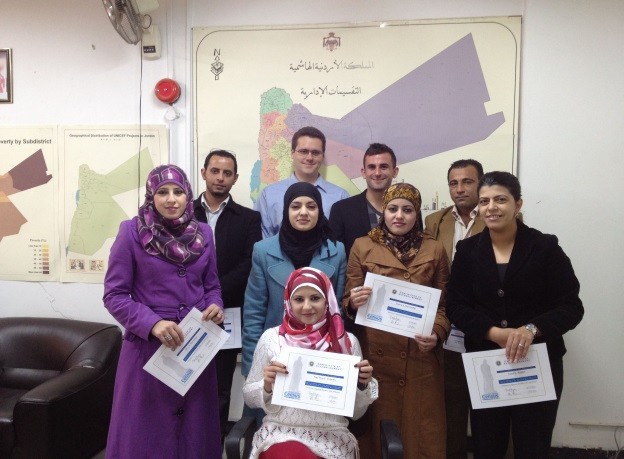Background

USAID/Jordan and the U.S. Census Bureau (USCB) have a relationship with the Jordan Department of Statistics (DOS) that spans over two decades. With USAID support, the USCB provided assistance to the DOS in preparation for the last two national censuses, which occurred in 1994 and 2004. In 2010, USCB was requested to provide the DOS with technical support in anticipation of the 2014 census.
In 2011, USAID/Jordan began to build DOS capacity by providing technical assistance and training in preparation for the 2014 census. The census was ultimately rescheduled to 2015, and activities were redeveloped based on USCB assessments to support the DOS through 2015.
Project overview
The Jordan Census Project (J-CenP) provides training and technical assistance to the Government of Jordan’s Department of Statistics (DOS) to develop its capacity to prepare for, execute, and disseminate data from the 2015 Census of Population and Housing. With USAID/Jordan support, the USCB will continue to provide technical assistance and training to DOS staff throughout the various phases of census preparation, which include census planning, work plan development, piloting the census, and data capture, analysis and dissemination. J-CenP began in April 2011 and will continue until September 2016.
Activities
As of March 2015, the project has completed the following:
- Assessment of DOS capacity, including cartographic and geographic information systems (GIS) analysis
- Feasibility study on using tablet technology and implications for operational dynamics of a census in Jordan
- USCB study tour for a DOS delegation
- Provided advice on tablet technology and design for use in gathering census data
- Workshop on GIS, digitizing and map editing
- Workshop on census planning and management
- Workshop on ensuring census data quality
- Provided technical assistance to the data users’ conference
- Provided technical assistance with GIS and satellite imagery to DOS
- Population projections workshop in the U.S. for DOS
- Workshops on data dissemination as well as sampling methodology and design
- GIS and field mapping operations in preparation for the census
The following activities are planned through the end of project:
- Technical assistance on specifications for the census handheld data collection system
- Technical assistance on manuals for supervisors and enumerators
- Technical Assistance with the Pilot Census
- Technical assistance and publicity for “Census in Schools” program
- Reviewing the census tabulation plan
- Workshops on survey frame and sample design for the census
- Development of analytical reports on demographics and household/housing characteristics
- Technical assistance on the census atlas, web GIS, and online data dissemination
- Demographic analysis and population projections
EXPECTED OUTCOMES

The Population and Housing Census is the backbone of the national statistical system for any country. It is the only operation that provides complete population counts at both national and local levels. These can be used for drawing administrative boundaries, apportioning political representation, and allocating fiscal resources. It provides demographic data for decision-making and policy planning in a great number of areas, and is the basis for the sampling frames of all large-scale surveys.
J-CenP support to the Jordan DOS impacts not only the health sector, but also has a broader impact that can potentially support virtually every activity within the USAID/Jordan strategy. In consultation with the GOJ, USAID has implemented an ambitious development assistance program to respond to the country’s primary development concerns related to economic development, democracy and governance, education, health and population, water, and energy. Successful planning and measurement of results in each of these sectors depends on the availability of quality data from the decennial Census of Population and Housing, population projections, and estimates from inter-census surveys that are only possible with high quality benchmark data provided by the census.
Furthermore, the census facilitates evidence-based policy decisions at the national level, and more equitable allocation of resources from the governorate to the local level, between urban and rural areas, and among more advantaged and less advantaged Jordanians – including the poor, the disabled and the unemployed.
Broad thematic areas that will also benefit from quality census data and from inter-census estimates and projections include the following:
- Measurement and evaluation
- Planning for infrastructure, services, and labor force
- Democracy, governance and reform
- Private sector investment







Comment
Make a general inquiry or suggest an improvement.